Management and Organizations 11.
VerifiedAdded on 2022/11/13
|12
|4426
|2
AI Summary
1. Written report
2. Presentation
Contribute Materials
Your contribution can guide someone’s learning journey. Share your
documents today.
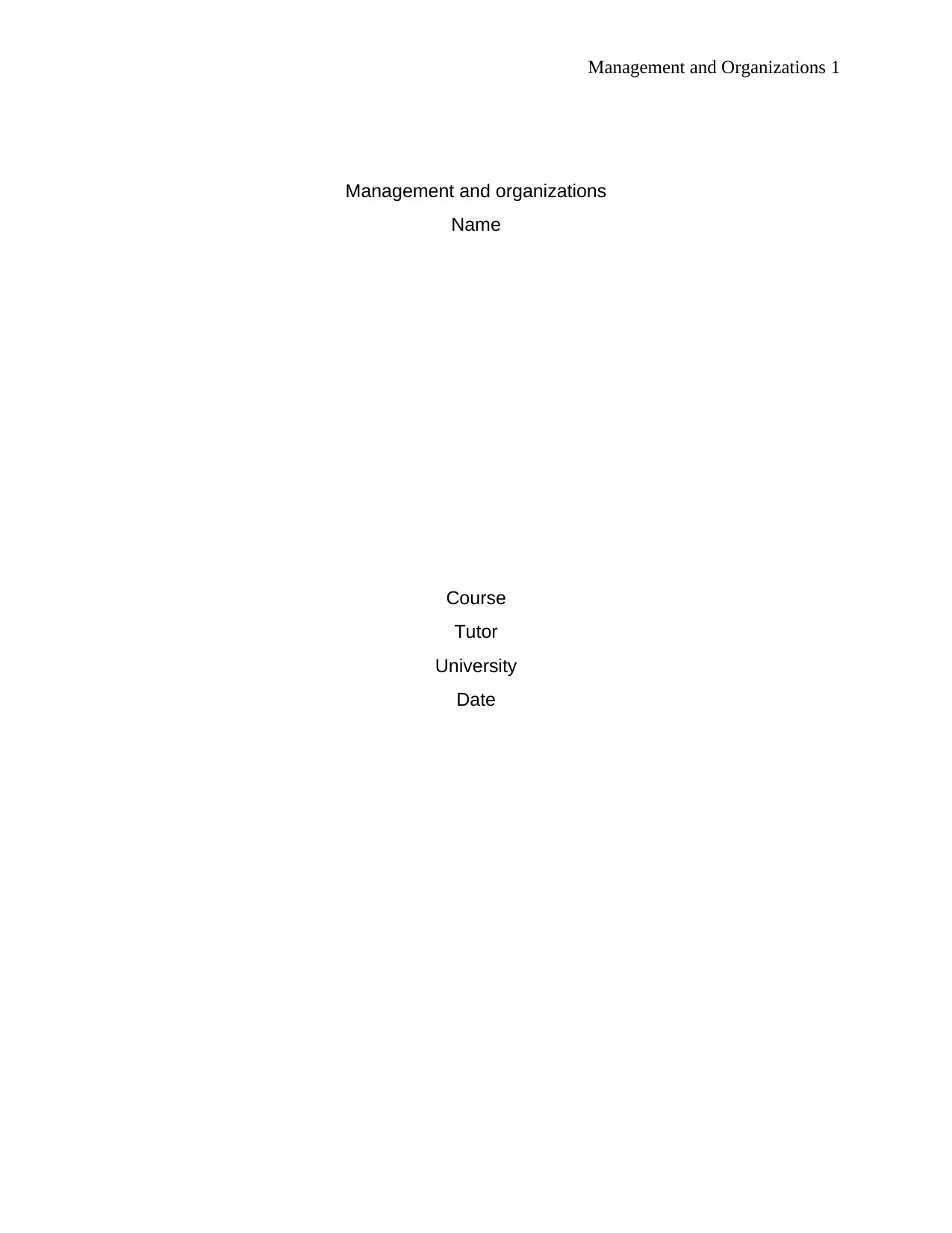
Management and Organizations 1
Management and organizations
Name
Course
Tutor
University
Date
Management and organizations
Name
Course
Tutor
University
Date
Secure Best Marks with AI Grader
Need help grading? Try our AI Grader for instant feedback on your assignments.
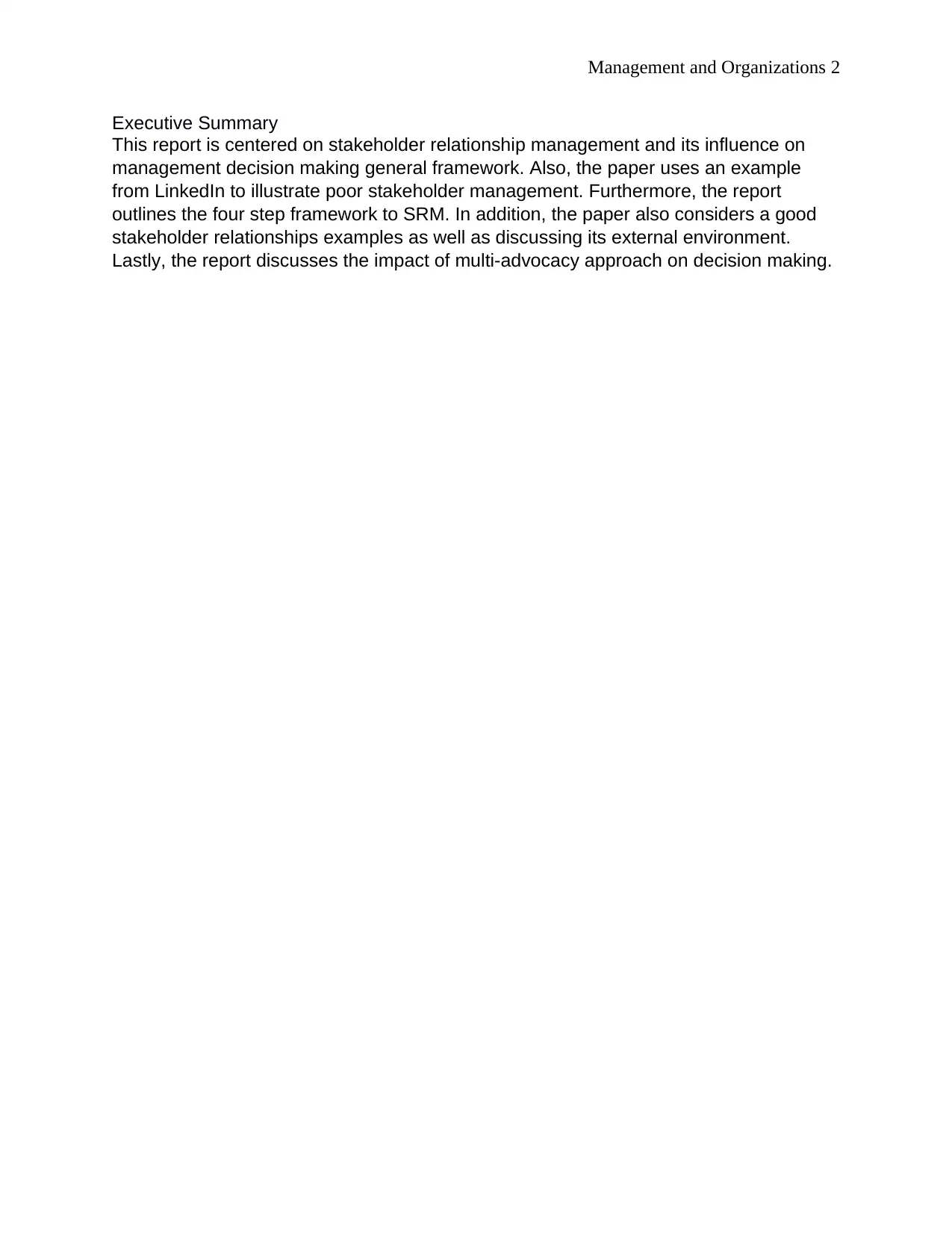
Management and Organizations 2
Executive Summary
This report is centered on stakeholder relationship management and its influence on
management decision making general framework. Also, the paper uses an example
from LinkedIn to illustrate poor stakeholder management. Furthermore, the report
outlines the four step framework to SRM. In addition, the paper also considers a good
stakeholder relationships examples as well as discussing its external environment.
Lastly, the report discusses the impact of multi-advocacy approach on decision making.
Executive Summary
This report is centered on stakeholder relationship management and its influence on
management decision making general framework. Also, the paper uses an example
from LinkedIn to illustrate poor stakeholder management. Furthermore, the report
outlines the four step framework to SRM. In addition, the paper also considers a good
stakeholder relationships examples as well as discussing its external environment.
Lastly, the report discusses the impact of multi-advocacy approach on decision making.
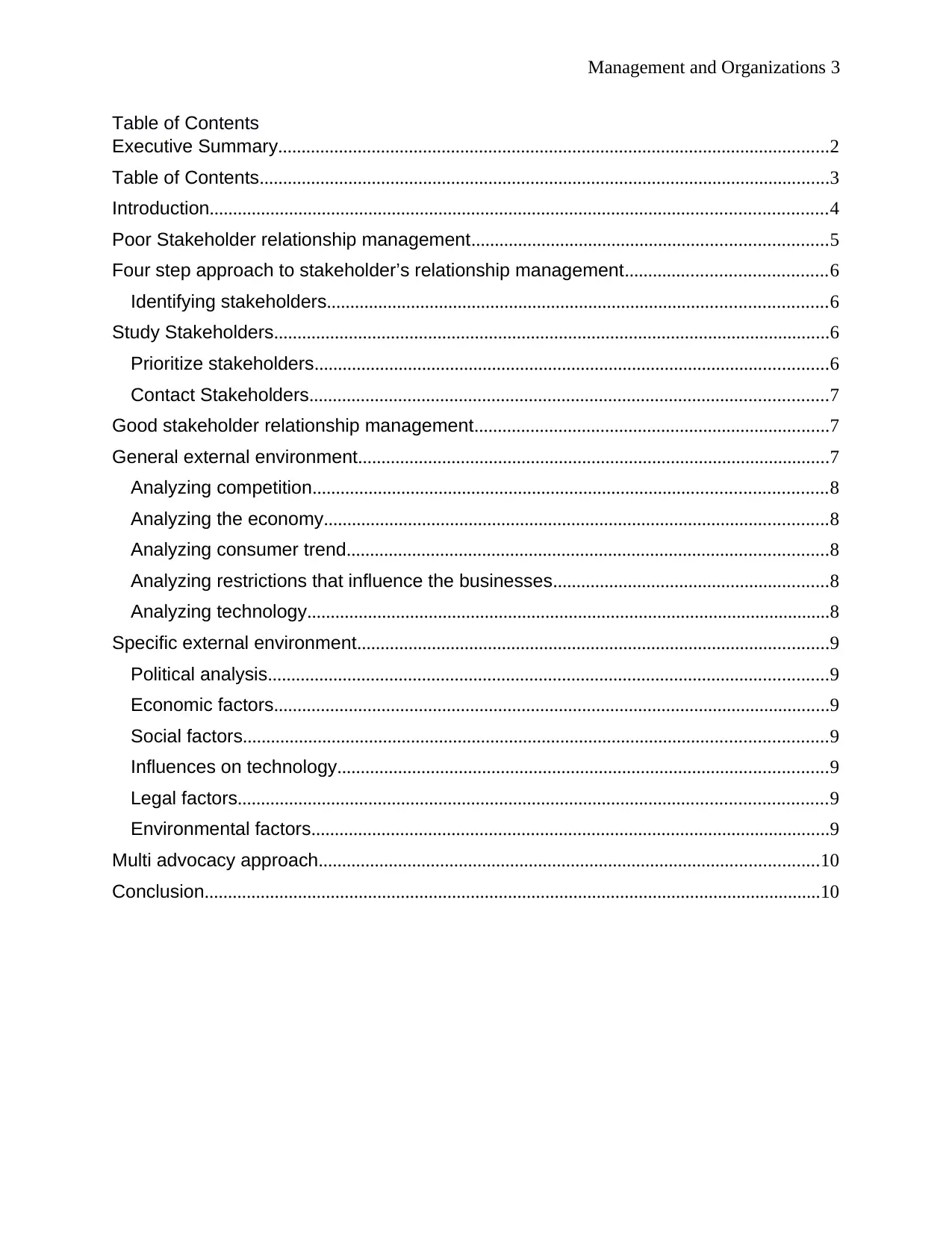
Management and Organizations 3
Table of Contents
Executive Summary......................................................................................................................2
Table of Contents..........................................................................................................................3
Introduction....................................................................................................................................4
Poor Stakeholder relationship management............................................................................5
Four step approach to stakeholder’s relationship management...........................................6
Identifying stakeholders...........................................................................................................6
Study Stakeholders.......................................................................................................................6
Prioritize stakeholders..............................................................................................................6
Contact Stakeholders...............................................................................................................7
Good stakeholder relationship management............................................................................7
General external environment.....................................................................................................7
Analyzing competition..............................................................................................................8
Analyzing the economy............................................................................................................8
Analyzing consumer trend.......................................................................................................8
Analyzing restrictions that influence the businesses...........................................................8
Analyzing technology................................................................................................................8
Specific external environment.....................................................................................................9
Political analysis........................................................................................................................9
Economic factors.......................................................................................................................9
Social factors.............................................................................................................................9
Influences on technology.........................................................................................................9
Legal factors..............................................................................................................................9
Environmental factors...............................................................................................................9
Multi advocacy approach...........................................................................................................10
Conclusion....................................................................................................................................10
Table of Contents
Executive Summary......................................................................................................................2
Table of Contents..........................................................................................................................3
Introduction....................................................................................................................................4
Poor Stakeholder relationship management............................................................................5
Four step approach to stakeholder’s relationship management...........................................6
Identifying stakeholders...........................................................................................................6
Study Stakeholders.......................................................................................................................6
Prioritize stakeholders..............................................................................................................6
Contact Stakeholders...............................................................................................................7
Good stakeholder relationship management............................................................................7
General external environment.....................................................................................................7
Analyzing competition..............................................................................................................8
Analyzing the economy............................................................................................................8
Analyzing consumer trend.......................................................................................................8
Analyzing restrictions that influence the businesses...........................................................8
Analyzing technology................................................................................................................8
Specific external environment.....................................................................................................9
Political analysis........................................................................................................................9
Economic factors.......................................................................................................................9
Social factors.............................................................................................................................9
Influences on technology.........................................................................................................9
Legal factors..............................................................................................................................9
Environmental factors...............................................................................................................9
Multi advocacy approach...........................................................................................................10
Conclusion....................................................................................................................................10
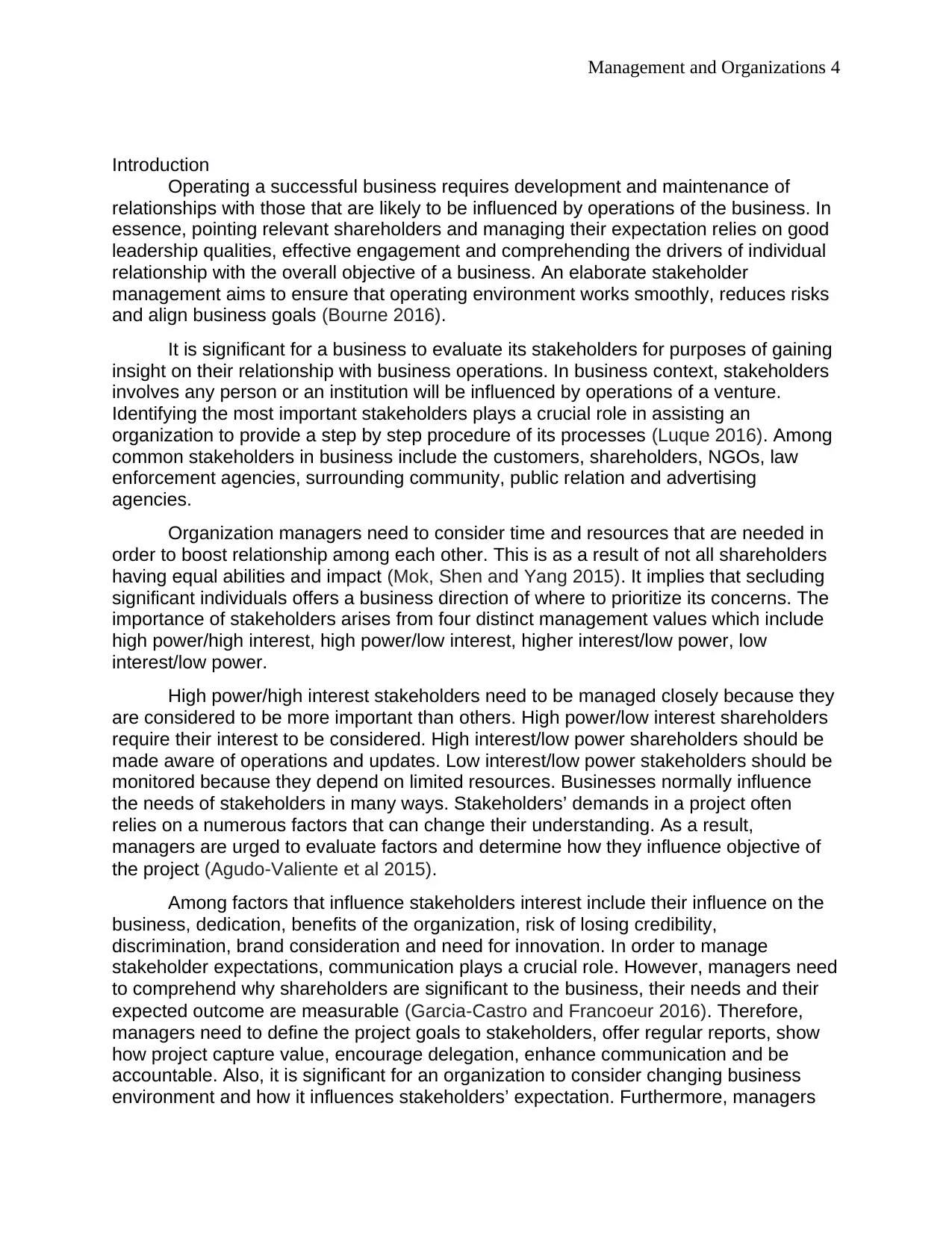
Management and Organizations 4
Introduction
Operating a successful business requires development and maintenance of
relationships with those that are likely to be influenced by operations of the business. In
essence, pointing relevant shareholders and managing their expectation relies on good
leadership qualities, effective engagement and comprehending the drivers of individual
relationship with the overall objective of a business. An elaborate stakeholder
management aims to ensure that operating environment works smoothly, reduces risks
and align business goals (Bourne 2016).
It is significant for a business to evaluate its stakeholders for purposes of gaining
insight on their relationship with business operations. In business context, stakeholders
involves any person or an institution will be influenced by operations of a venture.
Identifying the most important stakeholders plays a crucial role in assisting an
organization to provide a step by step procedure of its processes (Luque 2016). Among
common stakeholders in business include the customers, shareholders, NGOs, law
enforcement agencies, surrounding community, public relation and advertising
agencies.
Organization managers need to consider time and resources that are needed in
order to boost relationship among each other. This is as a result of not all shareholders
having equal abilities and impact (Mok, Shen and Yang 2015). It implies that secluding
significant individuals offers a business direction of where to prioritize its concerns. The
importance of stakeholders arises from four distinct management values which include
high power/high interest, high power/low interest, higher interest/low power, low
interest/low power.
High power/high interest stakeholders need to be managed closely because they
are considered to be more important than others. High power/low interest shareholders
require their interest to be considered. High interest/low power shareholders should be
made aware of operations and updates. Low interest/low power stakeholders should be
monitored because they depend on limited resources. Businesses normally influence
the needs of stakeholders in many ways. Stakeholders’ demands in a project often
relies on a numerous factors that can change their understanding. As a result,
managers are urged to evaluate factors and determine how they influence objective of
the project (Agudo‐Valiente et al 2015).
Among factors that influence stakeholders interest include their influence on the
business, dedication, benefits of the organization, risk of losing credibility,
discrimination, brand consideration and need for innovation. In order to manage
stakeholder expectations, communication plays a crucial role. However, managers need
to comprehend why shareholders are significant to the business, their needs and their
expected outcome are measurable (Garcia‐Castro and Francoeur 2016). Therefore,
managers need to define the project goals to stakeholders, offer regular reports, show
how project capture value, encourage delegation, enhance communication and be
accountable. Also, it is significant for an organization to consider changing business
environment and how it influences stakeholders’ expectation. Furthermore, managers
Introduction
Operating a successful business requires development and maintenance of
relationships with those that are likely to be influenced by operations of the business. In
essence, pointing relevant shareholders and managing their expectation relies on good
leadership qualities, effective engagement and comprehending the drivers of individual
relationship with the overall objective of a business. An elaborate stakeholder
management aims to ensure that operating environment works smoothly, reduces risks
and align business goals (Bourne 2016).
It is significant for a business to evaluate its stakeholders for purposes of gaining
insight on their relationship with business operations. In business context, stakeholders
involves any person or an institution will be influenced by operations of a venture.
Identifying the most important stakeholders plays a crucial role in assisting an
organization to provide a step by step procedure of its processes (Luque 2016). Among
common stakeholders in business include the customers, shareholders, NGOs, law
enforcement agencies, surrounding community, public relation and advertising
agencies.
Organization managers need to consider time and resources that are needed in
order to boost relationship among each other. This is as a result of not all shareholders
having equal abilities and impact (Mok, Shen and Yang 2015). It implies that secluding
significant individuals offers a business direction of where to prioritize its concerns. The
importance of stakeholders arises from four distinct management values which include
high power/high interest, high power/low interest, higher interest/low power, low
interest/low power.
High power/high interest stakeholders need to be managed closely because they
are considered to be more important than others. High power/low interest shareholders
require their interest to be considered. High interest/low power shareholders should be
made aware of operations and updates. Low interest/low power stakeholders should be
monitored because they depend on limited resources. Businesses normally influence
the needs of stakeholders in many ways. Stakeholders’ demands in a project often
relies on a numerous factors that can change their understanding. As a result,
managers are urged to evaluate factors and determine how they influence objective of
the project (Agudo‐Valiente et al 2015).
Among factors that influence stakeholders interest include their influence on the
business, dedication, benefits of the organization, risk of losing credibility,
discrimination, brand consideration and need for innovation. In order to manage
stakeholder expectations, communication plays a crucial role. However, managers need
to comprehend why shareholders are significant to the business, their needs and their
expected outcome are measurable (Garcia‐Castro and Francoeur 2016). Therefore,
managers need to define the project goals to stakeholders, offer regular reports, show
how project capture value, encourage delegation, enhance communication and be
accountable. Also, it is significant for an organization to consider changing business
environment and how it influences stakeholders’ expectation. Furthermore, managers
Secure Best Marks with AI Grader
Need help grading? Try our AI Grader for instant feedback on your assignments.
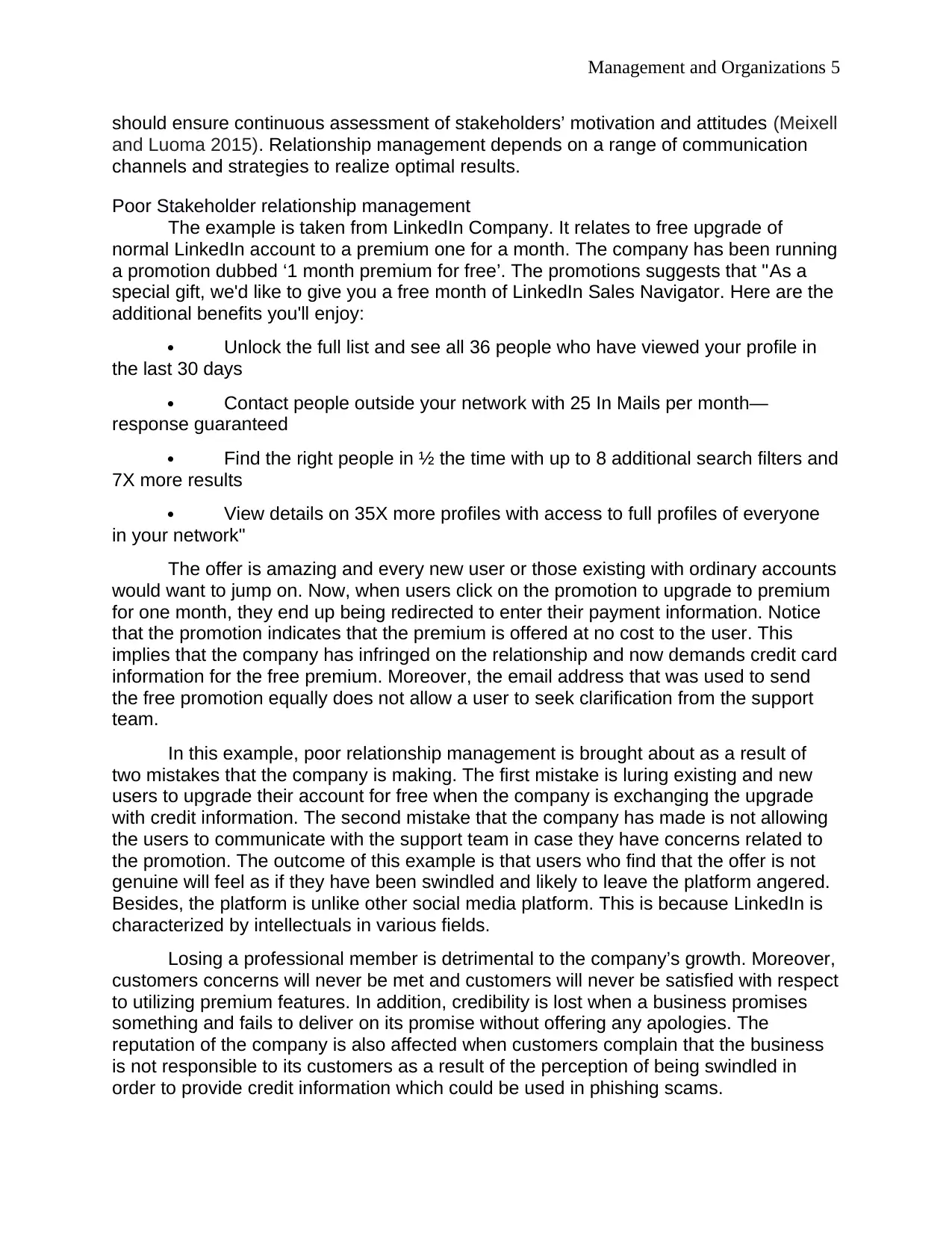
Management and Organizations 5
should ensure continuous assessment of stakeholders’ motivation and attitudes (Meixell
and Luoma 2015). Relationship management depends on a range of communication
channels and strategies to realize optimal results.
Poor Stakeholder relationship management
The example is taken from LinkedIn Company. It relates to free upgrade of
normal LinkedIn account to a premium one for a month. The company has been running
a promotion dubbed ‘1 month premium for free’. The promotions suggests that "As a
special gift, we'd like to give you a free month of LinkedIn Sales Navigator. Here are the
additional benefits you'll enjoy:
Unlock the full list and see all 36 people who have viewed your profile in
the last 30 days
Contact people outside your network with 25 In Mails per month—
response guaranteed
Find the right people in ½ the time with up to 8 additional search filters and
7X more results
View details on 35X more profiles with access to full profiles of everyone
in your network"
The offer is amazing and every new user or those existing with ordinary accounts
would want to jump on. Now, when users click on the promotion to upgrade to premium
for one month, they end up being redirected to enter their payment information. Notice
that the promotion indicates that the premium is offered at no cost to the user. This
implies that the company has infringed on the relationship and now demands credit card
information for the free premium. Moreover, the email address that was used to send
the free promotion equally does not allow a user to seek clarification from the support
team.
In this example, poor relationship management is brought about as a result of
two mistakes that the company is making. The first mistake is luring existing and new
users to upgrade their account for free when the company is exchanging the upgrade
with credit information. The second mistake that the company has made is not allowing
the users to communicate with the support team in case they have concerns related to
the promotion. The outcome of this example is that users who find that the offer is not
genuine will feel as if they have been swindled and likely to leave the platform angered.
Besides, the platform is unlike other social media platform. This is because LinkedIn is
characterized by intellectuals in various fields.
Losing a professional member is detrimental to the company’s growth. Moreover,
customers concerns will never be met and customers will never be satisfied with respect
to utilizing premium features. In addition, credibility is lost when a business promises
something and fails to deliver on its promise without offering any apologies. The
reputation of the company is also affected when customers complain that the business
is not responsible to its customers as a result of the perception of being swindled in
order to provide credit information which could be used in phishing scams.
should ensure continuous assessment of stakeholders’ motivation and attitudes (Meixell
and Luoma 2015). Relationship management depends on a range of communication
channels and strategies to realize optimal results.
Poor Stakeholder relationship management
The example is taken from LinkedIn Company. It relates to free upgrade of
normal LinkedIn account to a premium one for a month. The company has been running
a promotion dubbed ‘1 month premium for free’. The promotions suggests that "As a
special gift, we'd like to give you a free month of LinkedIn Sales Navigator. Here are the
additional benefits you'll enjoy:
Unlock the full list and see all 36 people who have viewed your profile in
the last 30 days
Contact people outside your network with 25 In Mails per month—
response guaranteed
Find the right people in ½ the time with up to 8 additional search filters and
7X more results
View details on 35X more profiles with access to full profiles of everyone
in your network"
The offer is amazing and every new user or those existing with ordinary accounts
would want to jump on. Now, when users click on the promotion to upgrade to premium
for one month, they end up being redirected to enter their payment information. Notice
that the promotion indicates that the premium is offered at no cost to the user. This
implies that the company has infringed on the relationship and now demands credit card
information for the free premium. Moreover, the email address that was used to send
the free promotion equally does not allow a user to seek clarification from the support
team.
In this example, poor relationship management is brought about as a result of
two mistakes that the company is making. The first mistake is luring existing and new
users to upgrade their account for free when the company is exchanging the upgrade
with credit information. The second mistake that the company has made is not allowing
the users to communicate with the support team in case they have concerns related to
the promotion. The outcome of this example is that users who find that the offer is not
genuine will feel as if they have been swindled and likely to leave the platform angered.
Besides, the platform is unlike other social media platform. This is because LinkedIn is
characterized by intellectuals in various fields.
Losing a professional member is detrimental to the company’s growth. Moreover,
customers concerns will never be met and customers will never be satisfied with respect
to utilizing premium features. In addition, credibility is lost when a business promises
something and fails to deliver on its promise without offering any apologies. The
reputation of the company is also affected when customers complain that the business
is not responsible to its customers as a result of the perception of being swindled in
order to provide credit information which could be used in phishing scams.
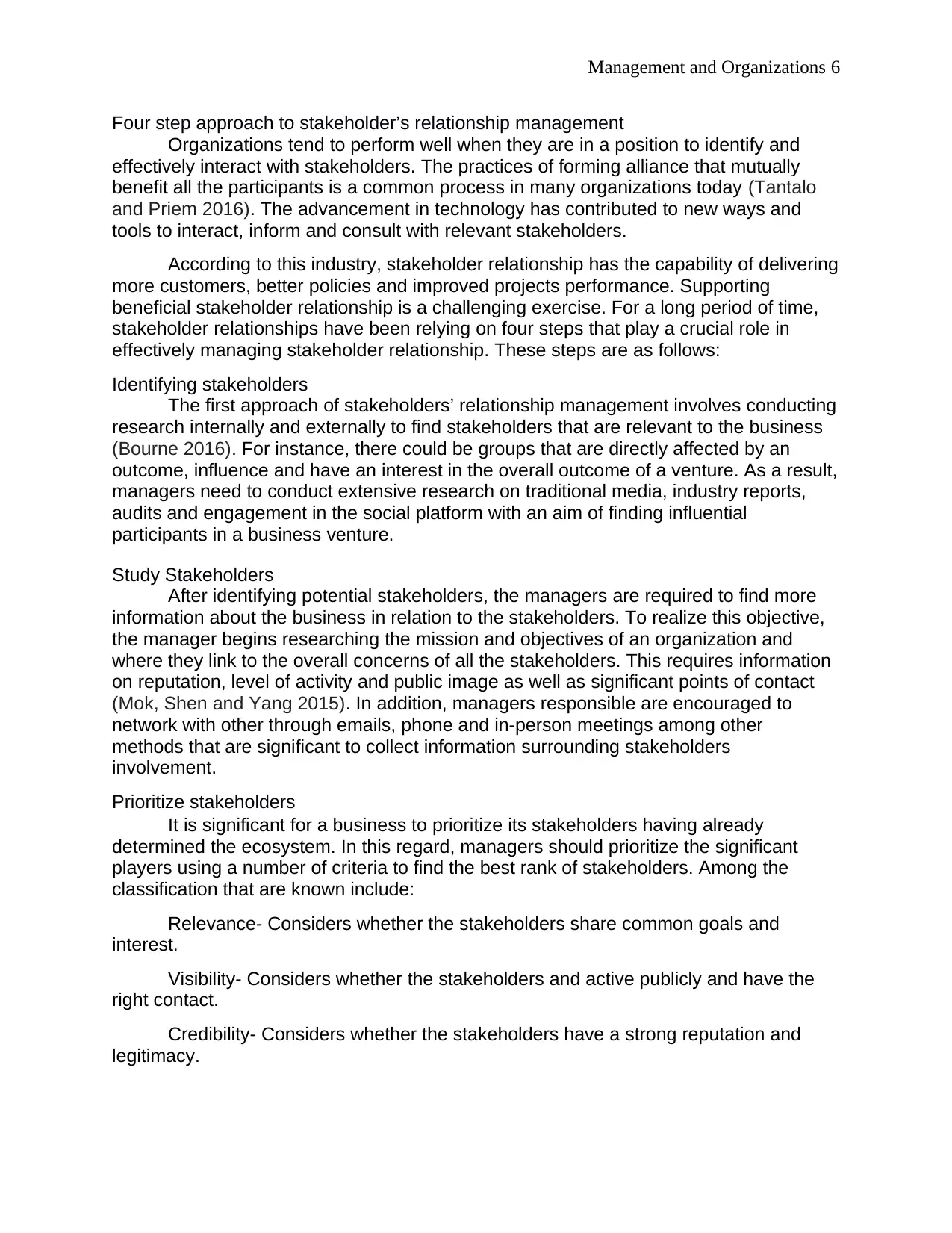
Management and Organizations 6
Four step approach to stakeholder’s relationship management
Organizations tend to perform well when they are in a position to identify and
effectively interact with stakeholders. The practices of forming alliance that mutually
benefit all the participants is a common process in many organizations today (Tantalo
and Priem 2016). The advancement in technology has contributed to new ways and
tools to interact, inform and consult with relevant stakeholders.
According to this industry, stakeholder relationship has the capability of delivering
more customers, better policies and improved projects performance. Supporting
beneficial stakeholder relationship is a challenging exercise. For a long period of time,
stakeholder relationships have been relying on four steps that play a crucial role in
effectively managing stakeholder relationship. These steps are as follows:
Identifying stakeholders
The first approach of stakeholders’ relationship management involves conducting
research internally and externally to find stakeholders that are relevant to the business
(Bourne 2016). For instance, there could be groups that are directly affected by an
outcome, influence and have an interest in the overall outcome of a venture. As a result,
managers need to conduct extensive research on traditional media, industry reports,
audits and engagement in the social platform with an aim of finding influential
participants in a business venture.
Study Stakeholders
After identifying potential stakeholders, the managers are required to find more
information about the business in relation to the stakeholders. To realize this objective,
the manager begins researching the mission and objectives of an organization and
where they link to the overall concerns of all the stakeholders. This requires information
on reputation, level of activity and public image as well as significant points of contact
(Mok, Shen and Yang 2015). In addition, managers responsible are encouraged to
network with other through emails, phone and in-person meetings among other
methods that are significant to collect information surrounding stakeholders
involvement.
Prioritize stakeholders
It is significant for a business to prioritize its stakeholders having already
determined the ecosystem. In this regard, managers should prioritize the significant
players using a number of criteria to find the best rank of stakeholders. Among the
classification that are known include:
Relevance- Considers whether the stakeholders share common goals and
interest.
Visibility- Considers whether the stakeholders and active publicly and have the
right contact.
Credibility- Considers whether the stakeholders have a strong reputation and
legitimacy.
Four step approach to stakeholder’s relationship management
Organizations tend to perform well when they are in a position to identify and
effectively interact with stakeholders. The practices of forming alliance that mutually
benefit all the participants is a common process in many organizations today (Tantalo
and Priem 2016). The advancement in technology has contributed to new ways and
tools to interact, inform and consult with relevant stakeholders.
According to this industry, stakeholder relationship has the capability of delivering
more customers, better policies and improved projects performance. Supporting
beneficial stakeholder relationship is a challenging exercise. For a long period of time,
stakeholder relationships have been relying on four steps that play a crucial role in
effectively managing stakeholder relationship. These steps are as follows:
Identifying stakeholders
The first approach of stakeholders’ relationship management involves conducting
research internally and externally to find stakeholders that are relevant to the business
(Bourne 2016). For instance, there could be groups that are directly affected by an
outcome, influence and have an interest in the overall outcome of a venture. As a result,
managers need to conduct extensive research on traditional media, industry reports,
audits and engagement in the social platform with an aim of finding influential
participants in a business venture.
Study Stakeholders
After identifying potential stakeholders, the managers are required to find more
information about the business in relation to the stakeholders. To realize this objective,
the manager begins researching the mission and objectives of an organization and
where they link to the overall concerns of all the stakeholders. This requires information
on reputation, level of activity and public image as well as significant points of contact
(Mok, Shen and Yang 2015). In addition, managers responsible are encouraged to
network with other through emails, phone and in-person meetings among other
methods that are significant to collect information surrounding stakeholders
involvement.
Prioritize stakeholders
It is significant for a business to prioritize its stakeholders having already
determined the ecosystem. In this regard, managers should prioritize the significant
players using a number of criteria to find the best rank of stakeholders. Among the
classification that are known include:
Relevance- Considers whether the stakeholders share common goals and
interest.
Visibility- Considers whether the stakeholders and active publicly and have the
right contact.
Credibility- Considers whether the stakeholders have a strong reputation and
legitimacy.
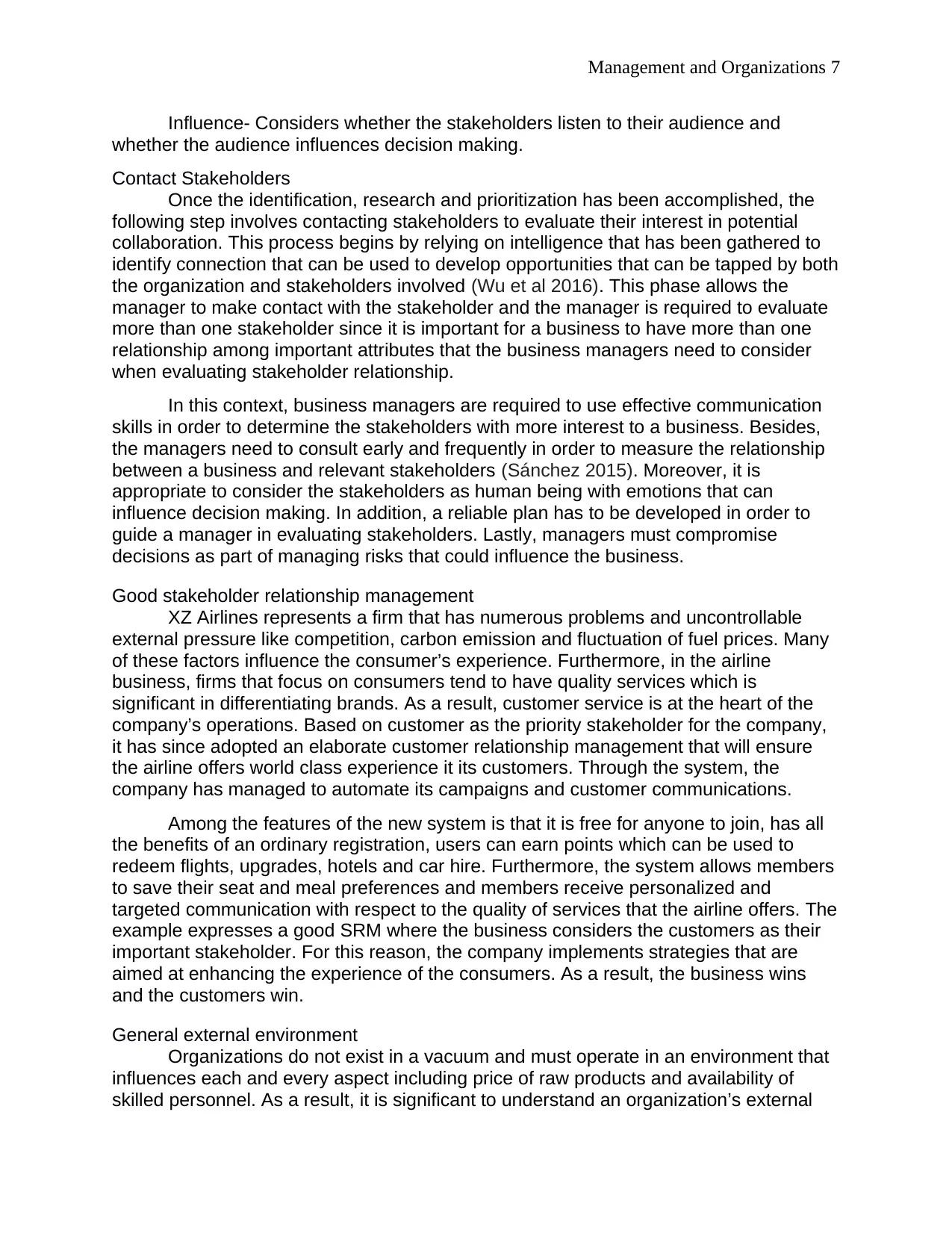
Management and Organizations 7
Influence- Considers whether the stakeholders listen to their audience and
whether the audience influences decision making.
Contact Stakeholders
Once the identification, research and prioritization has been accomplished, the
following step involves contacting stakeholders to evaluate their interest in potential
collaboration. This process begins by relying on intelligence that has been gathered to
identify connection that can be used to develop opportunities that can be tapped by both
the organization and stakeholders involved (Wu et al 2016). This phase allows the
manager to make contact with the stakeholder and the manager is required to evaluate
more than one stakeholder since it is important for a business to have more than one
relationship among important attributes that the business managers need to consider
when evaluating stakeholder relationship.
In this context, business managers are required to use effective communication
skills in order to determine the stakeholders with more interest to a business. Besides,
the managers need to consult early and frequently in order to measure the relationship
between a business and relevant stakeholders (Sánchez 2015). Moreover, it is
appropriate to consider the stakeholders as human being with emotions that can
influence decision making. In addition, a reliable plan has to be developed in order to
guide a manager in evaluating stakeholders. Lastly, managers must compromise
decisions as part of managing risks that could influence the business.
Good stakeholder relationship management
XZ Airlines represents a firm that has numerous problems and uncontrollable
external pressure like competition, carbon emission and fluctuation of fuel prices. Many
of these factors influence the consumer’s experience. Furthermore, in the airline
business, firms that focus on consumers tend to have quality services which is
significant in differentiating brands. As a result, customer service is at the heart of the
company’s operations. Based on customer as the priority stakeholder for the company,
it has since adopted an elaborate customer relationship management that will ensure
the airline offers world class experience it its customers. Through the system, the
company has managed to automate its campaigns and customer communications.
Among the features of the new system is that it is free for anyone to join, has all
the benefits of an ordinary registration, users can earn points which can be used to
redeem flights, upgrades, hotels and car hire. Furthermore, the system allows members
to save their seat and meal preferences and members receive personalized and
targeted communication with respect to the quality of services that the airline offers. The
example expresses a good SRM where the business considers the customers as their
important stakeholder. For this reason, the company implements strategies that are
aimed at enhancing the experience of the consumers. As a result, the business wins
and the customers win.
General external environment
Organizations do not exist in a vacuum and must operate in an environment that
influences each and every aspect including price of raw products and availability of
skilled personnel. As a result, it is significant to understand an organization’s external
Influence- Considers whether the stakeholders listen to their audience and
whether the audience influences decision making.
Contact Stakeholders
Once the identification, research and prioritization has been accomplished, the
following step involves contacting stakeholders to evaluate their interest in potential
collaboration. This process begins by relying on intelligence that has been gathered to
identify connection that can be used to develop opportunities that can be tapped by both
the organization and stakeholders involved (Wu et al 2016). This phase allows the
manager to make contact with the stakeholder and the manager is required to evaluate
more than one stakeholder since it is important for a business to have more than one
relationship among important attributes that the business managers need to consider
when evaluating stakeholder relationship.
In this context, business managers are required to use effective communication
skills in order to determine the stakeholders with more interest to a business. Besides,
the managers need to consult early and frequently in order to measure the relationship
between a business and relevant stakeholders (Sánchez 2015). Moreover, it is
appropriate to consider the stakeholders as human being with emotions that can
influence decision making. In addition, a reliable plan has to be developed in order to
guide a manager in evaluating stakeholders. Lastly, managers must compromise
decisions as part of managing risks that could influence the business.
Good stakeholder relationship management
XZ Airlines represents a firm that has numerous problems and uncontrollable
external pressure like competition, carbon emission and fluctuation of fuel prices. Many
of these factors influence the consumer’s experience. Furthermore, in the airline
business, firms that focus on consumers tend to have quality services which is
significant in differentiating brands. As a result, customer service is at the heart of the
company’s operations. Based on customer as the priority stakeholder for the company,
it has since adopted an elaborate customer relationship management that will ensure
the airline offers world class experience it its customers. Through the system, the
company has managed to automate its campaigns and customer communications.
Among the features of the new system is that it is free for anyone to join, has all
the benefits of an ordinary registration, users can earn points which can be used to
redeem flights, upgrades, hotels and car hire. Furthermore, the system allows members
to save their seat and meal preferences and members receive personalized and
targeted communication with respect to the quality of services that the airline offers. The
example expresses a good SRM where the business considers the customers as their
important stakeholder. For this reason, the company implements strategies that are
aimed at enhancing the experience of the consumers. As a result, the business wins
and the customers win.
General external environment
Organizations do not exist in a vacuum and must operate in an environment that
influences each and every aspect including price of raw products and availability of
skilled personnel. As a result, it is significant to understand an organization’s external
Paraphrase This Document
Need a fresh take? Get an instant paraphrase of this document with our AI Paraphraser
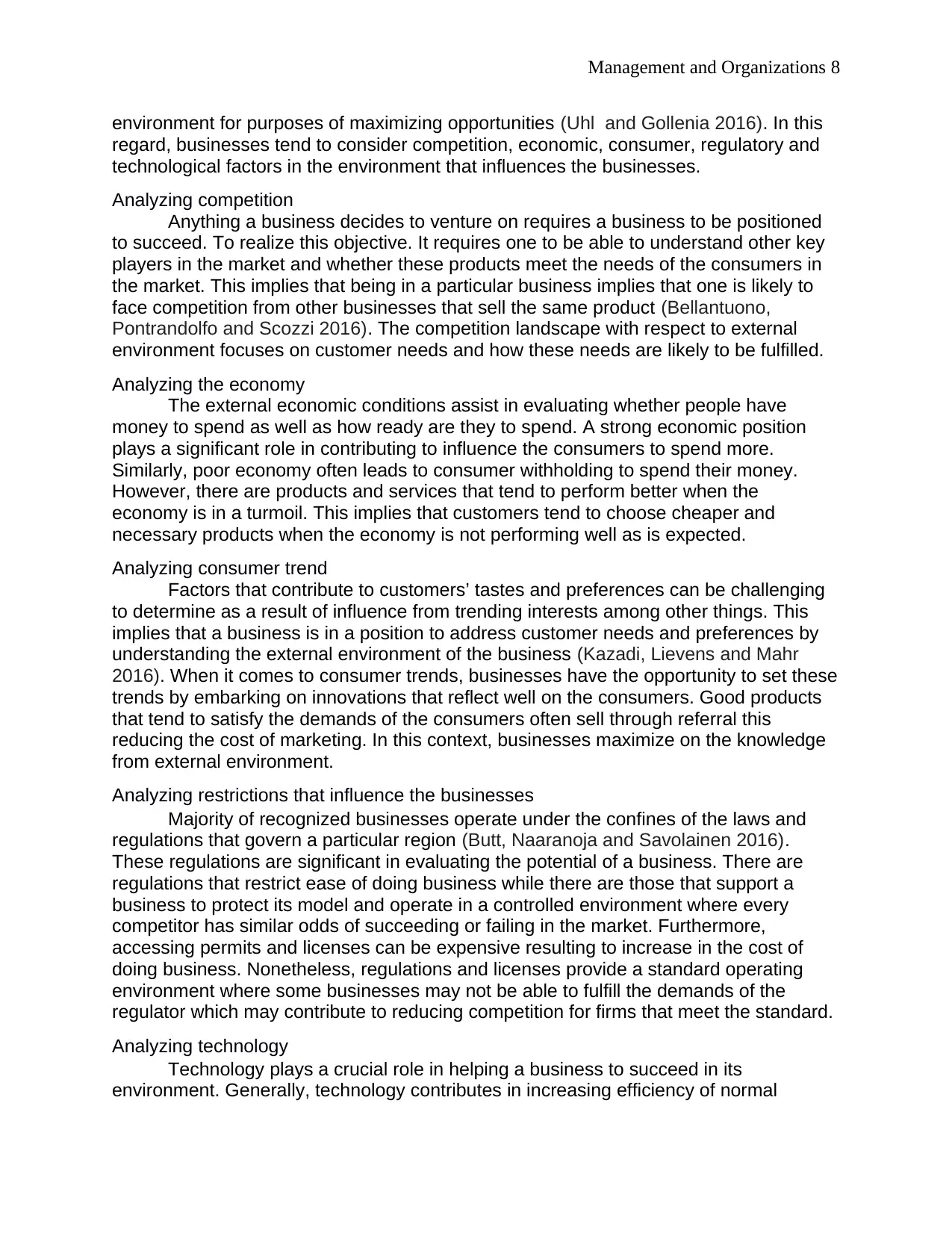
Management and Organizations 8
environment for purposes of maximizing opportunities (Uhl and Gollenia 2016). In this
regard, businesses tend to consider competition, economic, consumer, regulatory and
technological factors in the environment that influences the businesses.
Analyzing competition
Anything a business decides to venture on requires a business to be positioned
to succeed. To realize this objective. It requires one to be able to understand other key
players in the market and whether these products meet the needs of the consumers in
the market. This implies that being in a particular business implies that one is likely to
face competition from other businesses that sell the same product (Bellantuono,
Pontrandolfo and Scozzi 2016). The competition landscape with respect to external
environment focuses on customer needs and how these needs are likely to be fulfilled.
Analyzing the economy
The external economic conditions assist in evaluating whether people have
money to spend as well as how ready are they to spend. A strong economic position
plays a significant role in contributing to influence the consumers to spend more.
Similarly, poor economy often leads to consumer withholding to spend their money.
However, there are products and services that tend to perform better when the
economy is in a turmoil. This implies that customers tend to choose cheaper and
necessary products when the economy is not performing well as is expected.
Analyzing consumer trend
Factors that contribute to customers’ tastes and preferences can be challenging
to determine as a result of influence from trending interests among other things. This
implies that a business is in a position to address customer needs and preferences by
understanding the external environment of the business (Kazadi, Lievens and Mahr
2016). When it comes to consumer trends, businesses have the opportunity to set these
trends by embarking on innovations that reflect well on the consumers. Good products
that tend to satisfy the demands of the consumers often sell through referral this
reducing the cost of marketing. In this context, businesses maximize on the knowledge
from external environment.
Analyzing restrictions that influence the businesses
Majority of recognized businesses operate under the confines of the laws and
regulations that govern a particular region (Butt, Naaranoja and Savolainen 2016).
These regulations are significant in evaluating the potential of a business. There are
regulations that restrict ease of doing business while there are those that support a
business to protect its model and operate in a controlled environment where every
competitor has similar odds of succeeding or failing in the market. Furthermore,
accessing permits and licenses can be expensive resulting to increase in the cost of
doing business. Nonetheless, regulations and licenses provide a standard operating
environment where some businesses may not be able to fulfill the demands of the
regulator which may contribute to reducing competition for firms that meet the standard.
Analyzing technology
Technology plays a crucial role in helping a business to succeed in its
environment. Generally, technology contributes in increasing efficiency of normal
environment for purposes of maximizing opportunities (Uhl and Gollenia 2016). In this
regard, businesses tend to consider competition, economic, consumer, regulatory and
technological factors in the environment that influences the businesses.
Analyzing competition
Anything a business decides to venture on requires a business to be positioned
to succeed. To realize this objective. It requires one to be able to understand other key
players in the market and whether these products meet the needs of the consumers in
the market. This implies that being in a particular business implies that one is likely to
face competition from other businesses that sell the same product (Bellantuono,
Pontrandolfo and Scozzi 2016). The competition landscape with respect to external
environment focuses on customer needs and how these needs are likely to be fulfilled.
Analyzing the economy
The external economic conditions assist in evaluating whether people have
money to spend as well as how ready are they to spend. A strong economic position
plays a significant role in contributing to influence the consumers to spend more.
Similarly, poor economy often leads to consumer withholding to spend their money.
However, there are products and services that tend to perform better when the
economy is in a turmoil. This implies that customers tend to choose cheaper and
necessary products when the economy is not performing well as is expected.
Analyzing consumer trend
Factors that contribute to customers’ tastes and preferences can be challenging
to determine as a result of influence from trending interests among other things. This
implies that a business is in a position to address customer needs and preferences by
understanding the external environment of the business (Kazadi, Lievens and Mahr
2016). When it comes to consumer trends, businesses have the opportunity to set these
trends by embarking on innovations that reflect well on the consumers. Good products
that tend to satisfy the demands of the consumers often sell through referral this
reducing the cost of marketing. In this context, businesses maximize on the knowledge
from external environment.
Analyzing restrictions that influence the businesses
Majority of recognized businesses operate under the confines of the laws and
regulations that govern a particular region (Butt, Naaranoja and Savolainen 2016).
These regulations are significant in evaluating the potential of a business. There are
regulations that restrict ease of doing business while there are those that support a
business to protect its model and operate in a controlled environment where every
competitor has similar odds of succeeding or failing in the market. Furthermore,
accessing permits and licenses can be expensive resulting to increase in the cost of
doing business. Nonetheless, regulations and licenses provide a standard operating
environment where some businesses may not be able to fulfill the demands of the
regulator which may contribute to reducing competition for firms that meet the standard.
Analyzing technology
Technology plays a crucial role in helping a business to succeed in its
environment. Generally, technology contributes in increasing efficiency of normal
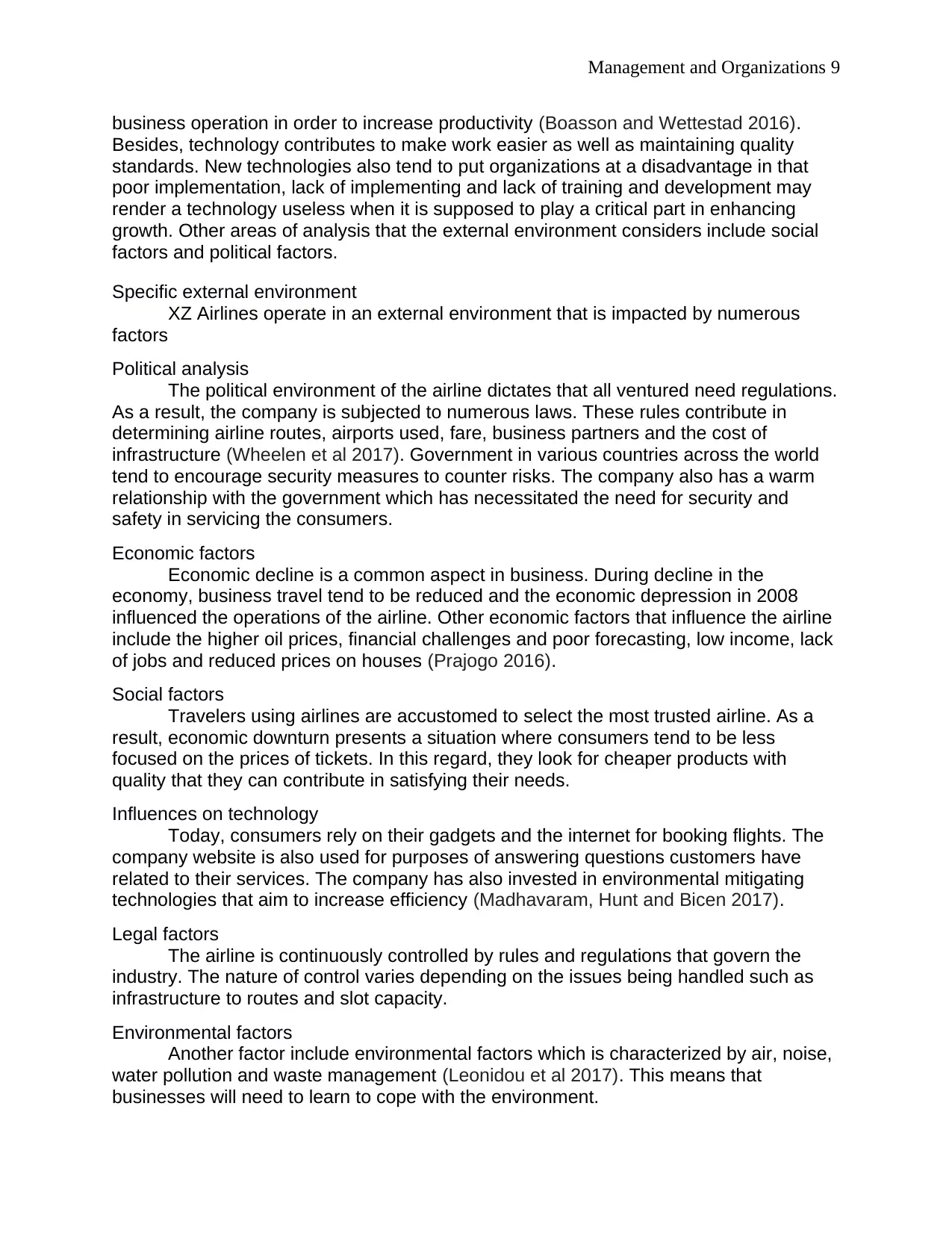
Management and Organizations 9
business operation in order to increase productivity (Boasson and Wettestad 2016).
Besides, technology contributes to make work easier as well as maintaining quality
standards. New technologies also tend to put organizations at a disadvantage in that
poor implementation, lack of implementing and lack of training and development may
render a technology useless when it is supposed to play a critical part in enhancing
growth. Other areas of analysis that the external environment considers include social
factors and political factors.
Specific external environment
XZ Airlines operate in an external environment that is impacted by numerous
factors
Political analysis
The political environment of the airline dictates that all ventured need regulations.
As a result, the company is subjected to numerous laws. These rules contribute in
determining airline routes, airports used, fare, business partners and the cost of
infrastructure (Wheelen et al 2017). Government in various countries across the world
tend to encourage security measures to counter risks. The company also has a warm
relationship with the government which has necessitated the need for security and
safety in servicing the consumers.
Economic factors
Economic decline is a common aspect in business. During decline in the
economy, business travel tend to be reduced and the economic depression in 2008
influenced the operations of the airline. Other economic factors that influence the airline
include the higher oil prices, financial challenges and poor forecasting, low income, lack
of jobs and reduced prices on houses (Prajogo 2016).
Social factors
Travelers using airlines are accustomed to select the most trusted airline. As a
result, economic downturn presents a situation where consumers tend to be less
focused on the prices of tickets. In this regard, they look for cheaper products with
quality that they can contribute in satisfying their needs.
Influences on technology
Today, consumers rely on their gadgets and the internet for booking flights. The
company website is also used for purposes of answering questions customers have
related to their services. The company has also invested in environmental mitigating
technologies that aim to increase efficiency (Madhavaram, Hunt and Bicen 2017).
Legal factors
The airline is continuously controlled by rules and regulations that govern the
industry. The nature of control varies depending on the issues being handled such as
infrastructure to routes and slot capacity.
Environmental factors
Another factor include environmental factors which is characterized by air, noise,
water pollution and waste management (Leonidou et al 2017). This means that
businesses will need to learn to cope with the environment.
business operation in order to increase productivity (Boasson and Wettestad 2016).
Besides, technology contributes to make work easier as well as maintaining quality
standards. New technologies also tend to put organizations at a disadvantage in that
poor implementation, lack of implementing and lack of training and development may
render a technology useless when it is supposed to play a critical part in enhancing
growth. Other areas of analysis that the external environment considers include social
factors and political factors.
Specific external environment
XZ Airlines operate in an external environment that is impacted by numerous
factors
Political analysis
The political environment of the airline dictates that all ventured need regulations.
As a result, the company is subjected to numerous laws. These rules contribute in
determining airline routes, airports used, fare, business partners and the cost of
infrastructure (Wheelen et al 2017). Government in various countries across the world
tend to encourage security measures to counter risks. The company also has a warm
relationship with the government which has necessitated the need for security and
safety in servicing the consumers.
Economic factors
Economic decline is a common aspect in business. During decline in the
economy, business travel tend to be reduced and the economic depression in 2008
influenced the operations of the airline. Other economic factors that influence the airline
include the higher oil prices, financial challenges and poor forecasting, low income, lack
of jobs and reduced prices on houses (Prajogo 2016).
Social factors
Travelers using airlines are accustomed to select the most trusted airline. As a
result, economic downturn presents a situation where consumers tend to be less
focused on the prices of tickets. In this regard, they look for cheaper products with
quality that they can contribute in satisfying their needs.
Influences on technology
Today, consumers rely on their gadgets and the internet for booking flights. The
company website is also used for purposes of answering questions customers have
related to their services. The company has also invested in environmental mitigating
technologies that aim to increase efficiency (Madhavaram, Hunt and Bicen 2017).
Legal factors
The airline is continuously controlled by rules and regulations that govern the
industry. The nature of control varies depending on the issues being handled such as
infrastructure to routes and slot capacity.
Environmental factors
Another factor include environmental factors which is characterized by air, noise,
water pollution and waste management (Leonidou et al 2017). This means that
businesses will need to learn to cope with the environment.
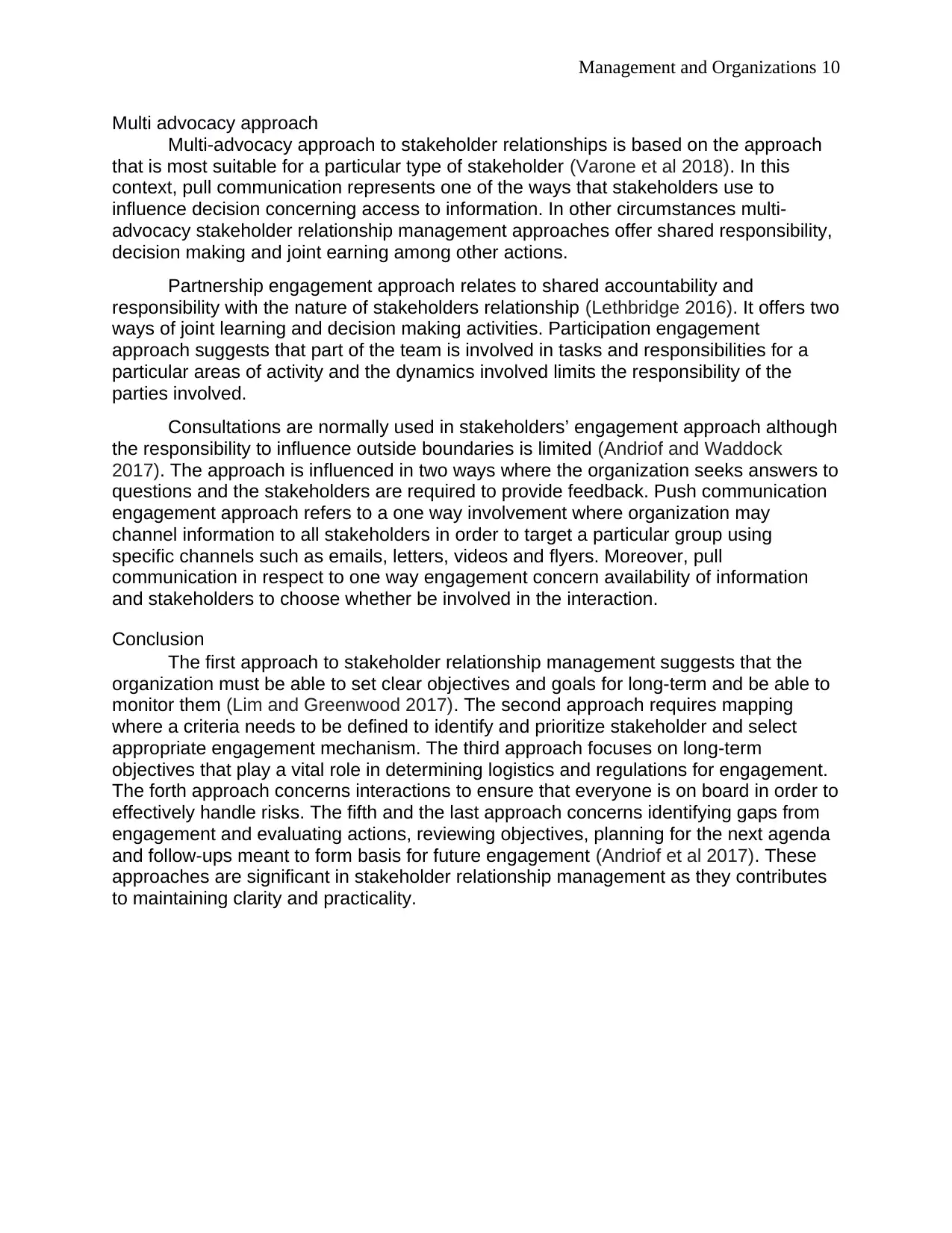
Management and Organizations 10
Multi advocacy approach
Multi-advocacy approach to stakeholder relationships is based on the approach
that is most suitable for a particular type of stakeholder (Varone et al 2018). In this
context, pull communication represents one of the ways that stakeholders use to
influence decision concerning access to information. In other circumstances multi-
advocacy stakeholder relationship management approaches offer shared responsibility,
decision making and joint earning among other actions.
Partnership engagement approach relates to shared accountability and
responsibility with the nature of stakeholders relationship (Lethbridge 2016). It offers two
ways of joint learning and decision making activities. Participation engagement
approach suggests that part of the team is involved in tasks and responsibilities for a
particular areas of activity and the dynamics involved limits the responsibility of the
parties involved.
Consultations are normally used in stakeholders’ engagement approach although
the responsibility to influence outside boundaries is limited (Andriof and Waddock
2017). The approach is influenced in two ways where the organization seeks answers to
questions and the stakeholders are required to provide feedback. Push communication
engagement approach refers to a one way involvement where organization may
channel information to all stakeholders in order to target a particular group using
specific channels such as emails, letters, videos and flyers. Moreover, pull
communication in respect to one way engagement concern availability of information
and stakeholders to choose whether be involved in the interaction.
Conclusion
The first approach to stakeholder relationship management suggests that the
organization must be able to set clear objectives and goals for long-term and be able to
monitor them (Lim and Greenwood 2017). The second approach requires mapping
where a criteria needs to be defined to identify and prioritize stakeholder and select
appropriate engagement mechanism. The third approach focuses on long-term
objectives that play a vital role in determining logistics and regulations for engagement.
The forth approach concerns interactions to ensure that everyone is on board in order to
effectively handle risks. The fifth and the last approach concerns identifying gaps from
engagement and evaluating actions, reviewing objectives, planning for the next agenda
and follow-ups meant to form basis for future engagement (Andriof et al 2017). These
approaches are significant in stakeholder relationship management as they contributes
to maintaining clarity and practicality.
Multi advocacy approach
Multi-advocacy approach to stakeholder relationships is based on the approach
that is most suitable for a particular type of stakeholder (Varone et al 2018). In this
context, pull communication represents one of the ways that stakeholders use to
influence decision concerning access to information. In other circumstances multi-
advocacy stakeholder relationship management approaches offer shared responsibility,
decision making and joint earning among other actions.
Partnership engagement approach relates to shared accountability and
responsibility with the nature of stakeholders relationship (Lethbridge 2016). It offers two
ways of joint learning and decision making activities. Participation engagement
approach suggests that part of the team is involved in tasks and responsibilities for a
particular areas of activity and the dynamics involved limits the responsibility of the
parties involved.
Consultations are normally used in stakeholders’ engagement approach although
the responsibility to influence outside boundaries is limited (Andriof and Waddock
2017). The approach is influenced in two ways where the organization seeks answers to
questions and the stakeholders are required to provide feedback. Push communication
engagement approach refers to a one way involvement where organization may
channel information to all stakeholders in order to target a particular group using
specific channels such as emails, letters, videos and flyers. Moreover, pull
communication in respect to one way engagement concern availability of information
and stakeholders to choose whether be involved in the interaction.
Conclusion
The first approach to stakeholder relationship management suggests that the
organization must be able to set clear objectives and goals for long-term and be able to
monitor them (Lim and Greenwood 2017). The second approach requires mapping
where a criteria needs to be defined to identify and prioritize stakeholder and select
appropriate engagement mechanism. The third approach focuses on long-term
objectives that play a vital role in determining logistics and regulations for engagement.
The forth approach concerns interactions to ensure that everyone is on board in order to
effectively handle risks. The fifth and the last approach concerns identifying gaps from
engagement and evaluating actions, reviewing objectives, planning for the next agenda
and follow-ups meant to form basis for future engagement (Andriof et al 2017). These
approaches are significant in stakeholder relationship management as they contributes
to maintaining clarity and practicality.
Secure Best Marks with AI Grader
Need help grading? Try our AI Grader for instant feedback on your assignments.
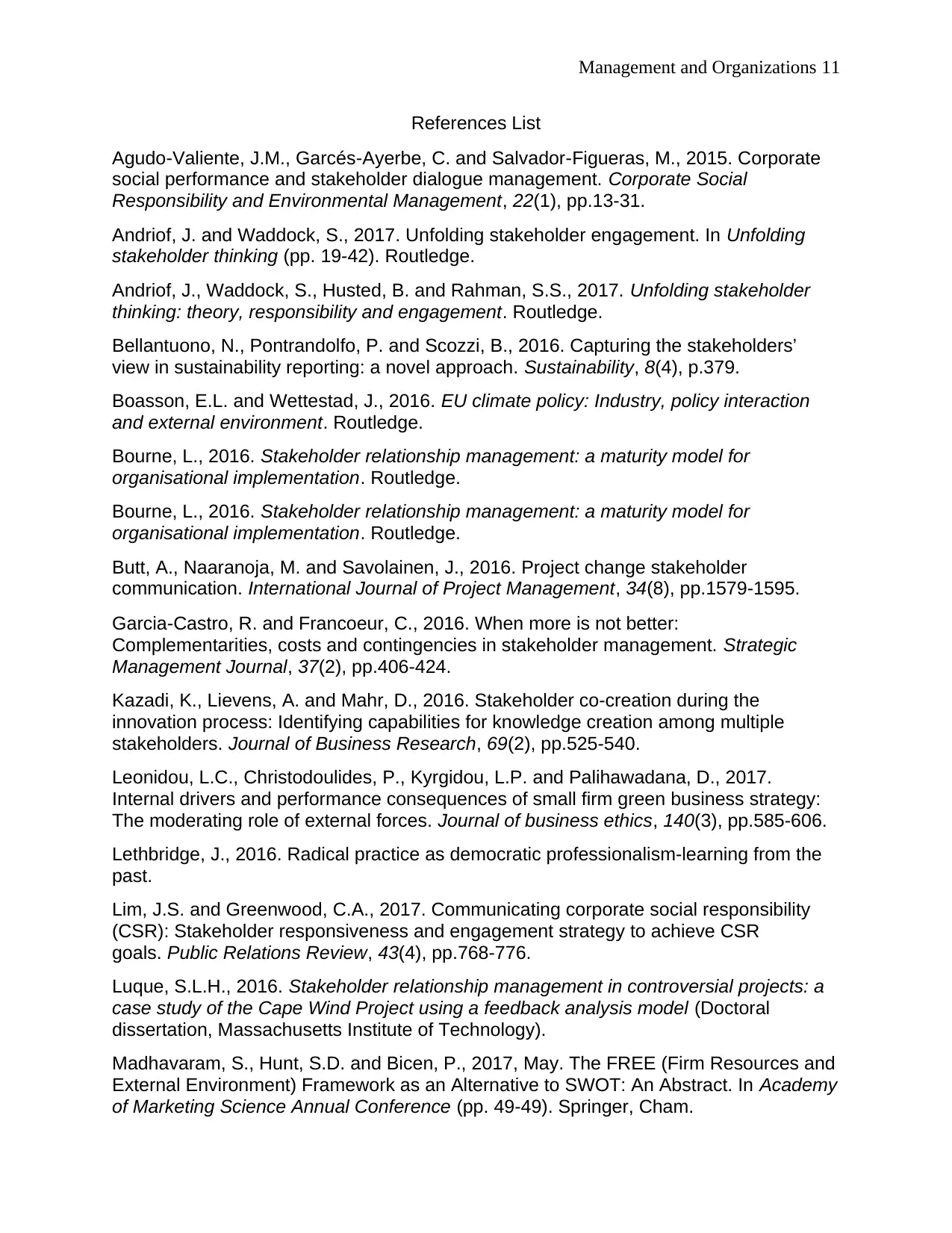
Management and Organizations 11
References List
Agudo‐Valiente, J.M., Garcés‐Ayerbe, C. and Salvador‐Figueras, M., 2015. Corporate
social performance and stakeholder dialogue management. Corporate Social
Responsibility and Environmental Management, 22(1), pp.13-31.
Andriof, J. and Waddock, S., 2017. Unfolding stakeholder engagement. In Unfolding
stakeholder thinking (pp. 19-42). Routledge.
Andriof, J., Waddock, S., Husted, B. and Rahman, S.S., 2017. Unfolding stakeholder
thinking: theory, responsibility and engagement. Routledge.
Bellantuono, N., Pontrandolfo, P. and Scozzi, B., 2016. Capturing the stakeholders’
view in sustainability reporting: a novel approach. Sustainability, 8(4), p.379.
Boasson, E.L. and Wettestad, J., 2016. EU climate policy: Industry, policy interaction
and external environment. Routledge.
Bourne, L., 2016. Stakeholder relationship management: a maturity model for
organisational implementation. Routledge.
Bourne, L., 2016. Stakeholder relationship management: a maturity model for
organisational implementation. Routledge.
Butt, A., Naaranoja, M. and Savolainen, J., 2016. Project change stakeholder
communication. International Journal of Project Management, 34(8), pp.1579-1595.
Garcia‐Castro, R. and Francoeur, C., 2016. When more is not better:
Complementarities, costs and contingencies in stakeholder management. Strategic
Management Journal, 37(2), pp.406-424.
Kazadi, K., Lievens, A. and Mahr, D., 2016. Stakeholder co-creation during the
innovation process: Identifying capabilities for knowledge creation among multiple
stakeholders. Journal of Business Research, 69(2), pp.525-540.
Leonidou, L.C., Christodoulides, P., Kyrgidou, L.P. and Palihawadana, D., 2017.
Internal drivers and performance consequences of small firm green business strategy:
The moderating role of external forces. Journal of business ethics, 140(3), pp.585-606.
Lethbridge, J., 2016. Radical practice as democratic professionalism-learning from the
past.
Lim, J.S. and Greenwood, C.A., 2017. Communicating corporate social responsibility
(CSR): Stakeholder responsiveness and engagement strategy to achieve CSR
goals. Public Relations Review, 43(4), pp.768-776.
Luque, S.L.H., 2016. Stakeholder relationship management in controversial projects: a
case study of the Cape Wind Project using a feedback analysis model (Doctoral
dissertation, Massachusetts Institute of Technology).
Madhavaram, S., Hunt, S.D. and Bicen, P., 2017, May. The FREE (Firm Resources and
External Environment) Framework as an Alternative to SWOT: An Abstract. In Academy
of Marketing Science Annual Conference (pp. 49-49). Springer, Cham.
References List
Agudo‐Valiente, J.M., Garcés‐Ayerbe, C. and Salvador‐Figueras, M., 2015. Corporate
social performance and stakeholder dialogue management. Corporate Social
Responsibility and Environmental Management, 22(1), pp.13-31.
Andriof, J. and Waddock, S., 2017. Unfolding stakeholder engagement. In Unfolding
stakeholder thinking (pp. 19-42). Routledge.
Andriof, J., Waddock, S., Husted, B. and Rahman, S.S., 2017. Unfolding stakeholder
thinking: theory, responsibility and engagement. Routledge.
Bellantuono, N., Pontrandolfo, P. and Scozzi, B., 2016. Capturing the stakeholders’
view in sustainability reporting: a novel approach. Sustainability, 8(4), p.379.
Boasson, E.L. and Wettestad, J., 2016. EU climate policy: Industry, policy interaction
and external environment. Routledge.
Bourne, L., 2016. Stakeholder relationship management: a maturity model for
organisational implementation. Routledge.
Bourne, L., 2016. Stakeholder relationship management: a maturity model for
organisational implementation. Routledge.
Butt, A., Naaranoja, M. and Savolainen, J., 2016. Project change stakeholder
communication. International Journal of Project Management, 34(8), pp.1579-1595.
Garcia‐Castro, R. and Francoeur, C., 2016. When more is not better:
Complementarities, costs and contingencies in stakeholder management. Strategic
Management Journal, 37(2), pp.406-424.
Kazadi, K., Lievens, A. and Mahr, D., 2016. Stakeholder co-creation during the
innovation process: Identifying capabilities for knowledge creation among multiple
stakeholders. Journal of Business Research, 69(2), pp.525-540.
Leonidou, L.C., Christodoulides, P., Kyrgidou, L.P. and Palihawadana, D., 2017.
Internal drivers and performance consequences of small firm green business strategy:
The moderating role of external forces. Journal of business ethics, 140(3), pp.585-606.
Lethbridge, J., 2016. Radical practice as democratic professionalism-learning from the
past.
Lim, J.S. and Greenwood, C.A., 2017. Communicating corporate social responsibility
(CSR): Stakeholder responsiveness and engagement strategy to achieve CSR
goals. Public Relations Review, 43(4), pp.768-776.
Luque, S.L.H., 2016. Stakeholder relationship management in controversial projects: a
case study of the Cape Wind Project using a feedback analysis model (Doctoral
dissertation, Massachusetts Institute of Technology).
Madhavaram, S., Hunt, S.D. and Bicen, P., 2017, May. The FREE (Firm Resources and
External Environment) Framework as an Alternative to SWOT: An Abstract. In Academy
of Marketing Science Annual Conference (pp. 49-49). Springer, Cham.
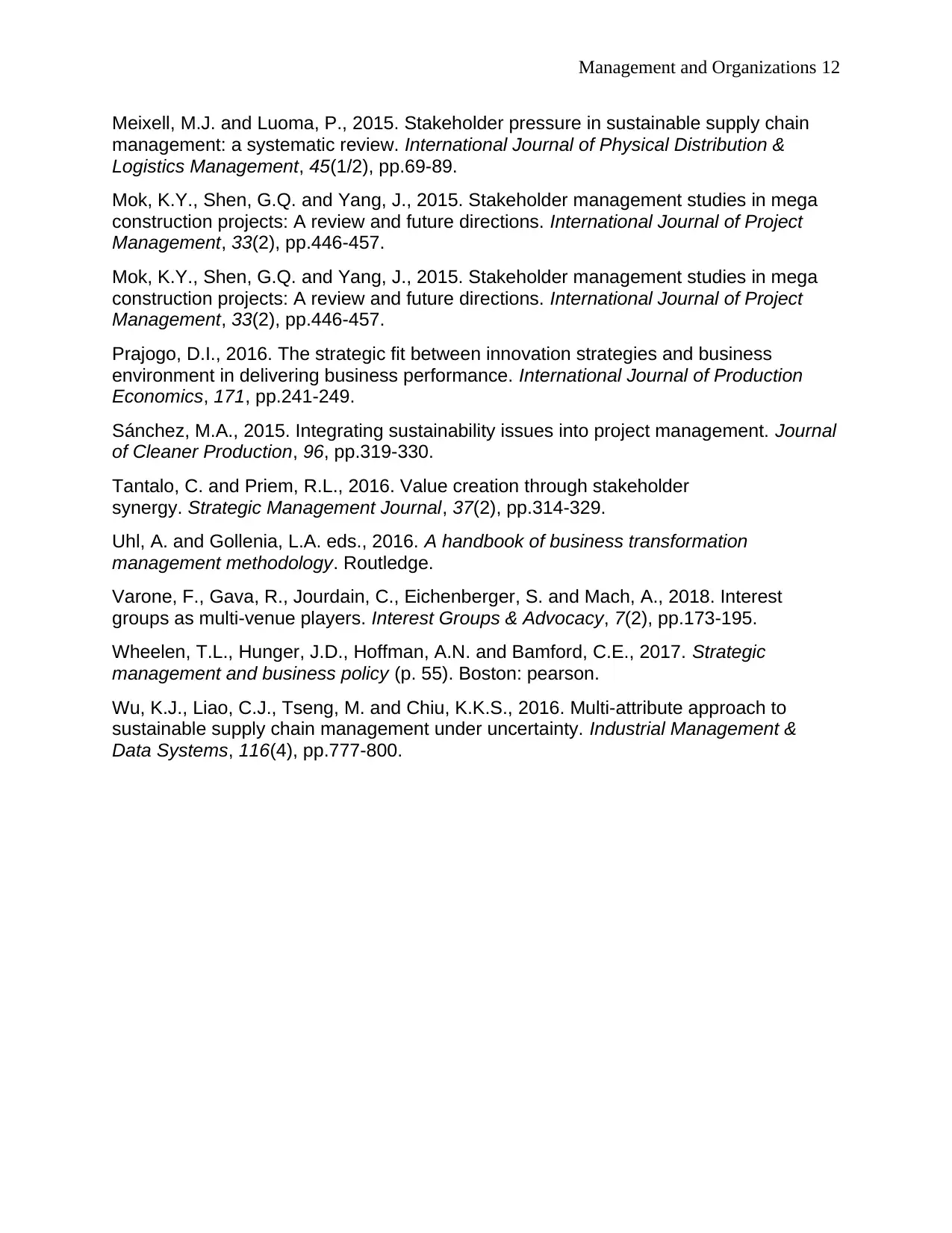
Management and Organizations 12
Meixell, M.J. and Luoma, P., 2015. Stakeholder pressure in sustainable supply chain
management: a systematic review. International Journal of Physical Distribution &
Logistics Management, 45(1/2), pp.69-89.
Mok, K.Y., Shen, G.Q. and Yang, J., 2015. Stakeholder management studies in mega
construction projects: A review and future directions. International Journal of Project
Management, 33(2), pp.446-457.
Mok, K.Y., Shen, G.Q. and Yang, J., 2015. Stakeholder management studies in mega
construction projects: A review and future directions. International Journal of Project
Management, 33(2), pp.446-457.
Prajogo, D.I., 2016. The strategic fit between innovation strategies and business
environment in delivering business performance. International Journal of Production
Economics, 171, pp.241-249.
Sánchez, M.A., 2015. Integrating sustainability issues into project management. Journal
of Cleaner Production, 96, pp.319-330.
Tantalo, C. and Priem, R.L., 2016. Value creation through stakeholder
synergy. Strategic Management Journal, 37(2), pp.314-329.
Uhl, A. and Gollenia, L.A. eds., 2016. A handbook of business transformation
management methodology. Routledge.
Varone, F., Gava, R., Jourdain, C., Eichenberger, S. and Mach, A., 2018. Interest
groups as multi-venue players. Interest Groups & Advocacy, 7(2), pp.173-195.
Wheelen, T.L., Hunger, J.D., Hoffman, A.N. and Bamford, C.E., 2017. Strategic
management and business policy (p. 55). Boston: pearson.
Wu, K.J., Liao, C.J., Tseng, M. and Chiu, K.K.S., 2016. Multi-attribute approach to
sustainable supply chain management under uncertainty. Industrial Management &
Data Systems, 116(4), pp.777-800.
Meixell, M.J. and Luoma, P., 2015. Stakeholder pressure in sustainable supply chain
management: a systematic review. International Journal of Physical Distribution &
Logistics Management, 45(1/2), pp.69-89.
Mok, K.Y., Shen, G.Q. and Yang, J., 2015. Stakeholder management studies in mega
construction projects: A review and future directions. International Journal of Project
Management, 33(2), pp.446-457.
Mok, K.Y., Shen, G.Q. and Yang, J., 2015. Stakeholder management studies in mega
construction projects: A review and future directions. International Journal of Project
Management, 33(2), pp.446-457.
Prajogo, D.I., 2016. The strategic fit between innovation strategies and business
environment in delivering business performance. International Journal of Production
Economics, 171, pp.241-249.
Sánchez, M.A., 2015. Integrating sustainability issues into project management. Journal
of Cleaner Production, 96, pp.319-330.
Tantalo, C. and Priem, R.L., 2016. Value creation through stakeholder
synergy. Strategic Management Journal, 37(2), pp.314-329.
Uhl, A. and Gollenia, L.A. eds., 2016. A handbook of business transformation
management methodology. Routledge.
Varone, F., Gava, R., Jourdain, C., Eichenberger, S. and Mach, A., 2018. Interest
groups as multi-venue players. Interest Groups & Advocacy, 7(2), pp.173-195.
Wheelen, T.L., Hunger, J.D., Hoffman, A.N. and Bamford, C.E., 2017. Strategic
management and business policy (p. 55). Boston: pearson.
Wu, K.J., Liao, C.J., Tseng, M. and Chiu, K.K.S., 2016. Multi-attribute approach to
sustainable supply chain management under uncertainty. Industrial Management &
Data Systems, 116(4), pp.777-800.
1 out of 12
Related Documents
Your All-in-One AI-Powered Toolkit for Academic Success.
+13062052269
info@desklib.com
Available 24*7 on WhatsApp / Email
![[object Object]](/_next/static/media/star-bottom.7253800d.svg)
Unlock your academic potential
© 2024 | Zucol Services PVT LTD | All rights reserved.



